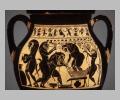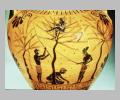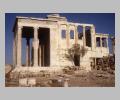Geographical and Historical Introduction
This brief section is intended to serve as a jumping-off point for the Overview by
providing a summary description of the physical environment of the Greek world and a very
short sketch of the end of Mycenaean civilization, which had flourished in
mainland
Greece1 for several hundred years before the period following 1200 B.C., with which the
main part of the Overview commences. The atlas in Perseus offers an alternative resource
for understanding the landscape of Greece visually.
The Landscape
The Greek homeland lay in and around the Aegean Sea. This section of the Mediterranean
Sea is dotted with numerous islands both large and small and flanked on the west by the
land mass called the Balkan Peninsula, which today forms the territory of the modern
nation of Greece, and flanked on the east by the coast of modern Turkey. Greeks also
came to live in the western Mediterranean and on the coast of north Africa, and some of
the most famous and prosperous of Greek cities were founded in southern Italy and on the
island of
Sicily (an area commonly referred to
by the Latin name “Magna Graecia”).
The
landscape of mainland Greece2 is dominated by mountains, many of which run in ranges along the Balkan
Peninsula in a northwest-southeast orientation. A chain of rugged peaks also fences
Greece from the northern Balkan peninsula and the region that was
Macedonia3 in antiquity. Although none of the mountains wrinkling the landscape of the
Greek mainland looms higher than 10,000 feet, their steep slopes were difficult to
traverse and operated as barriers separating communities. Some regions, such as
Thessaly4 in eastern central Greece,
Messenia5 in
southwestern Greece, the island of
Crete6 southeast of the mainland, and the island of Sicily, had large plains, but much
of Greek territory lacked such large-scale open areas. Settlements tended to spring up
where there were pockets of arable land nestled among the mountains or along the coast
where good harbors could be found. Greece's rivers were practically useless for trade
and communication because most of them slowed to a trickle during the many months each
year during which little or no rainfall occurred.
Natural Resources
The most plentiful natural resource of the mountains of mainland Greece was timber for
building houses and ships, but
deforestation7 may have already begun to occur in antiquity. In any case, Greeks eventually
began to import timber from the regions north of them. Some deposits of metal ore were
also scattered throughout Greek territory, as were clays suitable for making pottery and
sculpture. Scattered
quarries8 of fine stone such as marble
provided material for special buildings and works of art. The uneven distribution of
these resources meant that some areas and islands were considerably richer than others.
The
silver mines9 of Athens, for
example, contributed greatly to that state's famous prosperity in the fifth century, its
“Golden Age.”
Diet
Only about twenty to thirty percent of the total land area of Greece was arable. The
scarcity of level terrain ruled out the raising of cattle and horses on any large scale
in most areas;
pigs10,
sheep11, and
goats12 were the common livestock. The domestic
chicken13 had also been introduced into Greece from the Near East by
the seventh century B.C. Farmers mostly grew
barley14, the cereal staple of the
Greek diet15, with
wine
grapes16 and olives as the other
most important crops. Wine diluted with water was the most common beverage of Greeks and
drunk by almost everyone.
Olive oil17 furnished a main source of fat in the diet, as well as
serving many other uses such as a cleaning agent for bathing and a base for
perfumes.
The Highway of the Sea
The coastline of
mainland Greece18 was so jagged that almost all its communities were within forty miles of the
sea. Most Greeks, regardless of where they lived, never traveled very far from their
home; what few long-distance travelers there were customarily went by sea. Overland
transport was slow and expensive because rudimentary dirt paths served as the only roads
in the predominantly mountainous terrain where most Greeks lived. Their proximity to the
Mediterranean Sea allowed Greek entrepreneurs to use it as a highway for contact with
one another and for potentially lucrative international trade with, in particular, Egypt
and the Near East. But going to sea meant dangers from
pirates19
and storms, and prevailing winds and fierce gales almost ruled out sailing in winter.
Even in calm conditions sailors hugged the coast as much as possible and preferred to
put in to shore at night for safety. As the eighth-century poet Hesiod commented,
merchants needing to make a living took to the sea
“because an income
means life to poor mortals, but it is a terrible fate to die among the
waves.”20
Climate
The climate of Greece is what meteorologists call “Mediterranean,”
meaning intermittent heavy rain during a few winter months and hot, dry summers. Snow
falls on the upper ranges of the mountains in Greece, but most Greek communities
received little snow. Winters could be cold and blustery, however. Since the amount of
annual precipitation was highly variable, farming was a precarious business of boom and
bust, with drought and flood both to be feared. Like the modern residents of southern
California, however, whose climate is also “Mediterranean,” the
Greeks thought their climate the
world's best21 despite its hazards. “The Greeks occupy a middle position [between hot
and cold climates] and correspondingly enjoy both energy and intelligence,”
said the fourth-century philosopher Aristotle, who believed
climate controlled a
people's political destiny22. “For this reason they retain their freedom and have the best of
political institutions. In fact, if they could forge political unity among themselves,
they could control the rest of the world.”
Earlier History
Speakers of Greek had
lived at various locations23 on the mainland and islands of the Aegean for centuries upon centuries before
the period that saw the beginnings of written Greek literature and thus the creation of
the texts included in Perseus. The ancient Greeks never in any period of their history
constituted a nation in the modern political sense because their independent communities
never existed as a unified organization. Greeks
identified with each other
culturally24, however, because they spoke the same language and worshipped the
same gods, although with local variations in both cases.
Mycenaean Civilization
Greek civilization of the second millennium B.C., known as Mycenaean after the famous
archaeological site of
Mycenae25
in the northeastern Peloponnese (the peninsula that constitutes southern Greece), lies
outside the limits of the Overview, but perhaps some background information on it will
be helpful. Mycenaean civilization was organized around large architectural complexes
today referred to as “palaces.” These structures held many rooms,
often elaborately decorated with wall paintings, and were outfitted with luxuries like
bath tubs. The elite of
Mycenaean society26 lived very well, in comfort and style.
Political power was held by monarchical
rulers27 apparently controlling separate territories and never achieving unity among
themselves. These potent and wealthy rulers controlled redistributive economies, in
which agricultural products and other goods were brought into the palaces and then
redistributed throughout the society on a predetermined scheme rather than through free
markets. Writing, done in a syllabic script known today as Linear B, was used in
Mycenaean society primarily to record the transactions of this process, and presumably
only the scribes in charge of this record keeping knew how to write. Mycenaean society
seems to have been hierarchical, with social differentiation among people marked by
wealth, clothing, and titles. No written literature—prose or
poetry—is attested for this period.
The End of Mycenaean Civilization
The power and prosperity of Mycenaean Greece were lost in a period of
violent
conflict28 around 1200 B.C. that encompassed not only Greece but also much of the eastern
Mediterranean region of the Near East. The causes of this disaster are still obscure,
but strife among the principal centers seems to have played a significant role in the
undoing of Mycenaean Greece, as perhaps did also incursions by raiders from the sea. The
damage done to Greek society by the dissolution of the redistributive economies of
Mycenaean Greece after 1200 B.C. took centuries to repair. Only Athens seems to have
escaped wholesale disaster. In fact, the later Athenians, of the fifth century B.C.,
prided themselves on their unique status among the peoples of classical Greece:
“sprung from the soil”29 of their homeland (autochthonoi ), as they called themselves, they had not been forced to
emigrate in the turmoil that engulfed the rest of Greece in the twelfth and eleventh
centuries B.C.
The nature of the Athenians' boast gives some indication of the sorry fate of many
other Greeks at the start of the first millennium B.C. Uprooted from their homes, they
wandered abroad in search of new territory to settle. The
Ionian
Greeks,
30 who in later times inhabited the central coast of western
Anatolia, dated their emigration from the mainland to this period. Luxuries of Mycenaean
civilization like fine jewelry, knives inlaid with gold, and built-in bathtubs
disappeared. To an outside observer, Greek society at the end of the Mycenaean Age might
have seemed destined for irreversible economic and social decline, even oblivion. This
prediction would have been false.











